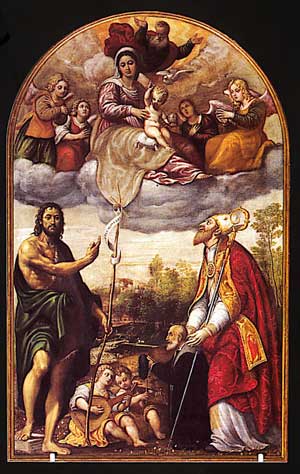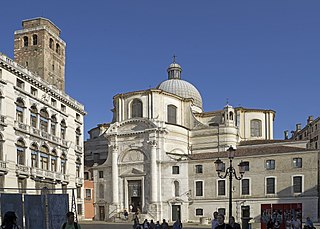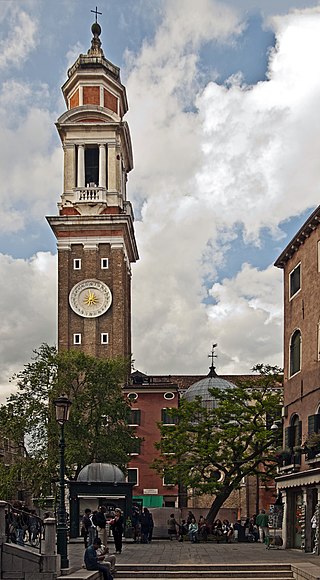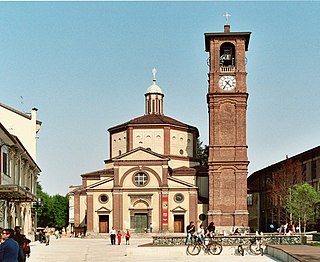
Cesare Baronio, C.O. was an Italian Oratorian, cardinal and historian of the Catholic Church. His best-known works are his Annales Ecclesiastici, which appeared in 12 folio volumes (1588–1607). He is under consideration for sainthood and, in 1845, Pope Benedict XIV declared him "Venerable."

Lorenzo Lotto was an Italian Renaissance painter, draughtsman, and illustrator, traditionally placed in the Venetian school, though much of his career was spent in other north Italian cities. He painted mainly altarpieces, religious subjects and portraits. He was active during the High Renaissance and the first half of the Mannerist period, but his work maintained a generally similar High Renaissance style throughout his career, although his nervous and eccentric posings and distortions represented a transitional stage to the Florentine and Roman Mannerists.

Pomponio Amalteo was an Italian painter of the Venetian school.

October 5 - Eastern Orthodox liturgical calendar - October 7

The Barbaro family was a patrician family of Venice. They were wealthy and influential and owned large estates in the Veneto above Treviso. Various members were noted as church leaders, diplomats, patrons of the arts, military commanders, philosophers, scholars, and scientists.

Eraclea is a small city and comune in the Metropolitan City of Venice, Veneto, northern Italy. It is located on the Adriatic coast between the towns of Caorle and Jesolo.
Fontanelle is a comune (municipality) in the province of Treviso, in the Italian region of Veneto, located about 45 kilometres (28 mi) north of Venice and about 25 kilometres (16 mi) northeast of Treviso.

The Chiesa dell'Angelo Raffaele is a church in Venice, northern Italy, located in the Dorsoduro sestiere. San Raffaele Arcangelo church is one of the only two churches in Venice that are possible to walk all around. It is located in Dorsoduro neighbourhood, close to San Basilio water bus stop.

Santa Maria Formosa, formally The Church of the Purification of Mary, is a church in Venice, northern Italy. It was erected in 1492 under the design by Renaissance architect Mauro Codussi. It lies on the site of a previous church dating from the 7th century, which, according to tradition, was one of the eight founded by San Magno, bishop of Oderzo. The name "formosa" relates to an alleged appearance of the Holy Virgin disguised as a voluptuous woman1.

Carbonera is a comune with 11,196 inhabitants in the province of Treviso, Veneto, northern Italy. It borders the municipalities of Treviso, Villorba, Spresiano, Maserada sul Piave, Breda di Piave and San Biagio di Callalta. The municipality of Carbonera includes the following villages or frazioni: Mignagola, Pezzan, Biban, San Giacomo di Musestrelle and Vascon.

San Geremia is a church in Venice, northern Italy, located in the sestiere of Cannaregio. The apse of the church faces the Grand Canal (Venice), between the Palazzo Labia and the Palazzo Flangini. The edifice is popular as the seat of the cult of Saint Lucy of Syracuse, whose remains are housed inside.

Saint Magnus of Anagni, also known as Magnus of Trani or Magnus of Fabrateria Vetus, is venerated as the patron saint of Anagni.

Magnus of Cuneo is venerated as a martyr and member of the legendary Theban Legion. The center of his cult is situated at the mountain sanctuary known as the Santuario di San Magno, in the Valle Grana, Castelmagno, in the province of Cuneo. His feast day is August 19.

The Church of Saints Michael and Magnus is a Roman Catholic church in Rome, Italy, dedicated to Saint Michael the Archangel and the Bishop Saint Magnus of Anagni. It lies on the northern slope of the Palazzolo hill, in Rione Borgo, near the Vatican, and is the national church dedicated to the Netherlands. It is also known as the "Church of the Frisians". In 1989, the church was granted to the Dutch community in Rome. A 19th century source calls the church Santi Michele e Magno in Sassia, due to a location on a Vico dei Sassoni.

The Chiesa dei Santi Apostoli di Cristo, commonly called San Apostoli, is a 7th-century Roman Catholic church located in the Cannaregio sestiere of the Italian city of Venice. It is one of the oldest churches in the city and has undergone numerous changes since its foundation. The present building is the result of a major reconstruction project which was undertaken in 1575. The church is notable particularly for the Cornaro Chapel, an important example of Early Renaissance architecture, added by Mauro Codussi during the 1490s. The chapel is the burial place of several members of the powerful Cornaro family, including Catherine Cornaro, Queen of Cyprus and Armenia. The church houses several works of art including pieces by Giambattista Tiepolo and Paolo Veronese.

The Basilica di San Pietro di Castello, commonly called San Pietro di Castello, is a Roman Catholic minor basilica of the Patriarch of Venice located in the Castello sestiere of the Italian city of Venice. The present building dates from the 16th century, but a church has stood on the site since at least the 7th century. From 1451 to 1807, it was the city's cathedral church, though hardly playing the usual dominant role of a cathedral, as it was overshadowed by the "state church" of San Marco and inconveniently located. During its history, the church has undergone a number of alterations and additions by some of Venice's most prominent architects. Andrea Palladio received his first commission in the city of Venice from the Patriarch Vincenzo Diedo to rebuild the facade and interior of St Pietro, but Diedo's death delayed the project.

Magnus was Archbishop of Milan from 518 to c. 530. He is honoured as a saint in the Catholic Church and Orthodox Church.

The Basilica of Saint Magnus is the principal church of the Italian town of Legnano, in the province of Milan. It is dedicated to the Saint Magnus, who was Archbishop of Milan from 518 to 530. The church was built from 1504 to 1513 in the Renaissance-style designed by Donato Bramante. The bell tower was added between the years 1752 and 1791. On 18 March 1950, Pope Pius XII named the Basilica of San Magno a minor basilica.
Giuseppe Segusini was an Italian neoclassical architect.

















